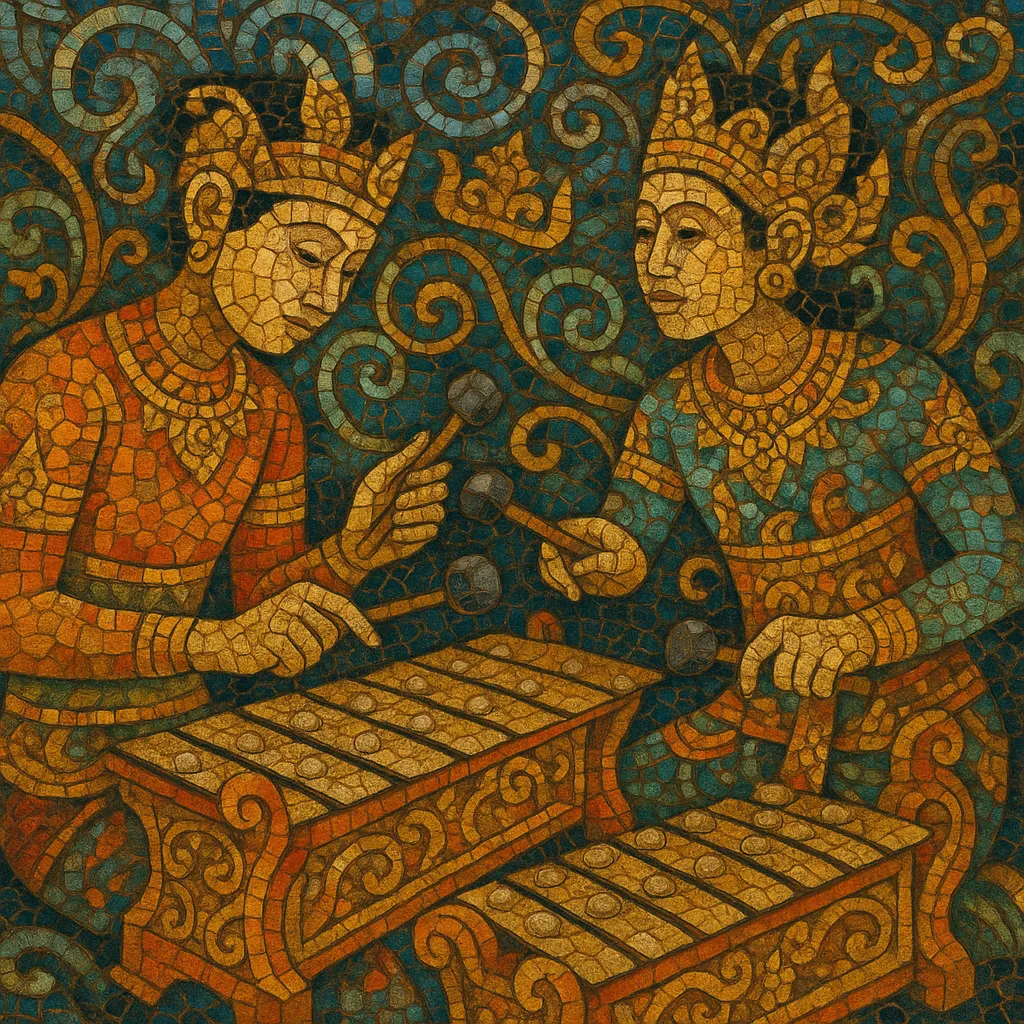Gamelan gender wayang is a Balinese chamber gamelan ensemble closely associated with wayang kulit (shadow-puppet theatre) and important life‑cycle rituals. It is typically scored for a quartet of metallophones called gender wayang, each with bronze keys suspended over bamboo resonators and struck with disc‑headed wooden mallets while the non‑striking hand executes precise damping.
The music features rapid interlocking (kotekan) between paired parts that create dazzling, filigreed textures above a core melody (pokok). Instruments are tuned in paired “beating” sets (pengumbang/pengisep) to produce ombak, the characteristic acoustic shimmer. Repertoires are cast in a five‑tone slendro‑like scale over roughly two octaves, with flexible cyclic phrasing that breathes with the drama of the puppetry and the cues of the dalang (puppeteer).
Gamelan gender wayang emerged in Bali as the specialized ensemble for wayang kulit (shadow‑puppet theatre) and for ritual contexts such as tooth‑filing and cremation ceremonies. Its intimate scale—most often two or four gender metallophones—suits the nuanced, conversational interplay required to accompany narration, song, and puppetry.
The ensemble’s defining traits—paired tuning (pengumbang/pengisep) that yields acoustic beating (ombak), interlocking kotekan between polos and sangsih parts, and a two‑octave, five‑tone slendro‑like scale—likely coalesced over centuries of Balinese court and village practice. The music supports dramatic pacing with flexible cycles, cadences, and cue‑driven transitions.
By the early 20th century, scholars and recordists had documented gender wayang alongside other Balinese gamelan types. Throughout the 20th and 21st centuries, village sekaa (ensembles) maintained oral transmission—teaching by rote, imitation, and incremental variation—while conservatories and international programs helped disseminate the style abroad.
Today, gender wayang remains central to ritual life and wayang performance, while touring ensembles and university groups outside Indonesia perform and study the repertoire. Contemporary Balinese composers and master performers continue to expand technique and pedagogy without compromising the ensemble’s ceremonial and narrative functions.
Use a quartet of gender wayang metallophones (two higher and two lower), each with about 10 bronze keys spanning two octaves of a five‑tone slendro‑like scale. Tune instruments in beating pairs (pengumbang/pengisep) to create ombak—the characteristic shimmering chorus.
Write interlocking kotekan between polos (principal) and sangsih (complementary) parts. Balance dense, rapid figurations with clear articulation and damping so that lines remain transparent. Let the two lower instruments outline the core melody (pokok) while the upper pair elaborate with ornamental figuration.
Think in flexible, breathing cycles rather than strict barlines. Shape phrases around cadences and dramatic cues from a dalang if accompanying wayang. Employ accelerandi and ritardandi to mirror scene tension, and use brief rests or held tones to articulate section boundaries (opening/pengawit, body/pengawak, faster closing/pengecet).
Compose a singable pokok, then weave ornamental patterns (including neighbor tones and repeated‑note tremoli) that interlock between parts. Keep voice‑leading smooth and idiomatic to the instrument’s damp‑and‑strike technique; every struck key should be consciously damped to avoid blurring.
Rehearse slowly to synchronize damping and mallet strokes, then increase tempo while maintaining evenness of attack and decay. Learn by ear: model phrases, then vary them incrementally, preserving contour and cadential goals. Record rehearsals to check the balance of ombak and the clarity of kotekan.
If composing for ritual or wayang, respect traditional modes, repertoire frameworks, and pacing. Align musical climaxes with narrative actions, and leave space for sung and spoken text. For concert works, you may integrate contemporary harmonies carefully, but keep the beating pairs and interlocking textures central.


